Analysis of the Electromagnetic Coupling Characteristics of Dual-Load Wireless Power Transmission Channels
Abstract
:1. Introduction
- Through theoretical analysis, the influence of cross-coupling between the receiving coils of the system in different coupling situations is compared.
- The electromagnetic field simulation software is used to analyze the transmission characteristics of the system when the coupling distance and load impedance of the transceiver end change, and the applicable working conditions under different coupling conditions are pointed out.
- An experimental platform was built to verify the validity of the theory and simulation analysis.
2. Modeling and Analysis of the Dual-Load Cooperative Coupling System
2.1. Equivalent Circuit Model
2.2. Analysis of the Efficiency of the Coupled System
3. Analysis of Coil Cross-Coupling Coefficient
4. Analysis of Transmission Parameters of Electromagnetic Coupling System
4.1. Finite Element Simulation Model
4.2. Analysis of Distance Characteristics
4.3. Analysis of Impedance Characteristics
5. Experiment and Analysis
6. Conclusions
Author Contributions
Funding
Conflicts of Interest
References
- Zhang, Z.; Pang, H.; Georgiadis, A. Wireless Power Transfer—An Overview. IEEE Trans. Ind. Electron. 2019, 66, 1044–1058. [Google Scholar] [CrossRef]
- Famili, A.; Stavrou, A. Eternal Flying: Optimal Placement of Wireless Chargers for Nonstop Drone Flights. In Proceedings of the 2022 International Conference on Electrical, Computer and Energy Technologies (ICECET), Prague, Czech Republic, 20–22 July 2022; pp. 1–6. [Google Scholar] [CrossRef]
- Yang, L.; Feng, B.; Zhang, Y.; Li, X.; Zhang, L.; Chen, X.; Nie, J.; Wen, H.; Tian, J.; Jian, J.; et al. Single Wire Capacitive Wireless Power Transfer System for Wearable Biomedical Sensors based on Flexible Graphene Film Material. IEEE Trans. Biomed. Circuits Syst. 2022. [Google Scholar] [CrossRef] [PubMed]
- Zhan, B.; Liu, S. Efficiency analysis of 13.56 MHz flexible wearable electronic Magnetically coupled resonance wireless energy transfer. In Proceedings of the 2022 23rd International Conference on Electronic Packaging Technology (ICEPT), Dalian, China, 10–13 August 2022; pp. 1–4. [Google Scholar] [CrossRef]
- Chen, K.W.K.; Cheng, K.W.E. Review of magnetic resonance technology, recent research trends and issues in EV wireless charging. In Proceedings of the 11th IET International Conference on Advances in Power System Control, Operation and Management (APSCOM 2018), Hong Kong, China, 11–15 November 2018; pp. 1–7. [Google Scholar] [CrossRef]
- Singh, A.; Singh, M. Design and Implementation of Wireless Power Transfer Using Class-E Resonant Inverter and Magnetic Resonance Coupling. In Proceedings of the 2022 IEEE IAS Global Conference on Emerging Technologies (GlobConET), Arad, Romania, 20–22 May 2022; pp. 987–992. [Google Scholar] [CrossRef]
- Baikova, E.N.; Baikov, A.V.; Romba, L. Resonance Tuning in Wireless Energy Transfer System. In Proceedings of the 2022 4th Global Power, Energy and Communication Conference (GPECOM), Nevsehir, Turkey, 14–17 June 2022; pp. 156–161. [Google Scholar] [CrossRef]
- Chung, Y.D.; Lee, C.Y. Effect and Influence of Double Resonance Couplings with Dual Resonance Frequencies for Wireless Power Multi-Charging Module in Superconducting MAGLEV Train. IEEE Trans. Appl. Supercond. 2022, 32, 3602806. [Google Scholar] [CrossRef]
- Demarchou, E.; Psomas, C.; Krikidis, I. On the Design of Magnetic Resonant Coupling for Wireless Power Transfer in Multicoil Networks. IEEE Wirel. Commun. Lett. 2022, 11, 406–410. [Google Scholar] [CrossRef]
- Rong, C.; He, X.; Wu, Y.; Qi, Y.; Wang, R.; Sun, Y.; Liu, M. Optimization Design of Resonance Coils with High Misalignment Tolerance for Drone Wireless Charging Based on Genetic Algorithm. IEEE Trans. Ind. Appl. 2022, 58, 1242–1253. [Google Scholar] [CrossRef]
- Zhang, Y.; Zhao, Z.; Chen, K. Frequency splitting analysis of magnetically-coupled resonant wireless power transfer. In Proceedings of the 2013 IEEE Energy Conversion Congress and Exposition, Denver, CO, USA, 15–19 September 2013; pp. 2227–2232. [Google Scholar] [CrossRef]
- Li, H.; Wang, K.; Huang, L.; Li, J.; Yang, X. Coil structure optimization method for improving coupling coefficient of wireless power transfer. In Proceedings of the 2015 IEEE Applied Power Electronics Conference and Exposition (APEC), Charlotte, NC, USA, 15–19 March 2015; pp. 2518–2521. [Google Scholar] [CrossRef]
- Mohammad, M.; Pries, J.L.; Onar, O.C.; Galigekere, V.P.; Su, G.-J.; Wilkins, J. Comparison of Magnetic Field Emission from Unipolar and Bipolar Coil-Based Wireless Charging Systems. In Proceedings of the 2020 IEEE Transportation Electrification Conference & Expo (ITEC), Chicago, IL, USA, 23–26 June 2020; pp. 1201–1207. [Google Scholar] [CrossRef]
- Hou, R.; Wang, X.; Wu, J.; Song, H.; Qu, Y. Research and Application of Dual-Load wireless power Transmission System. In Proceedings of the 2019 22nd International Conference on Electrical Machines and Systems (ICEMS), Harbin, China, 11–14 August 2019; pp. 1–5. [Google Scholar] [CrossRef]
- Cheng, C.; Zhou, Z.; Li, W.; Zhu, C.; Deng, Z.; Mi, C.C. A Multi-Load Wireless Power Transfer System with Series-Parallel-Series Compensation. IEEE Trans. Power Electron. 2019, 34, 7126–7130. [Google Scholar] [CrossRef]
- Zhou, Z.; Shi, Q.; Cheng, C.; Li, W.; Deng, Z.; Li, F.; Mi, C. A Multi-load Wireless Power Transfer System with Constant Voltage Outputs Using S-LCC Compensation. In Proceedings of the 2019 22nd International Conference on Electrical Machines and Systems (ICEMS), Harbin, China, 11–14 August 2019; pp. 1–6. [Google Scholar] [CrossRef]
- Cannon, B.L.; Hoburg, J.F.; Stancil, D.D.; Goldstein, S.C. Magnetic Resonant Coupling As a Potential Means for Wireless Power Transfer to Multiple Small Receivers. IEEE Trans. Power Electron. 2009, 24, 1819–1825. [Google Scholar] [CrossRef]
- Fu, M.; Zhang, T.; Zhu, X.; Luk, P.C.-K.; Ma, C. Compensation of Cross Coupling in Multiple-Receiver Wireless Power Transfer Systems. IEEE Trans. Ind. Inform. 2016, 12, 474–482. [Google Scholar] [CrossRef]
- Lee, K.; Cho, D. Analysis of wireless power transfer for adjustable power distribution among multiple receivers. IEEE Antennas Wirel. Propag. Lett. 2019, 14, 950–953. [Google Scholar] [CrossRef]
- Luo, C.; Qiu, D.; Gu, W.; Zhang, B.; Chen, Y.; Xiao, W. Multiload Wireless Power Transfer System with Constant Output Power and Efficiency. IEEE Trans. Ind. Appl. 2022, 58, 1101–1114. [Google Scholar] [CrossRef]
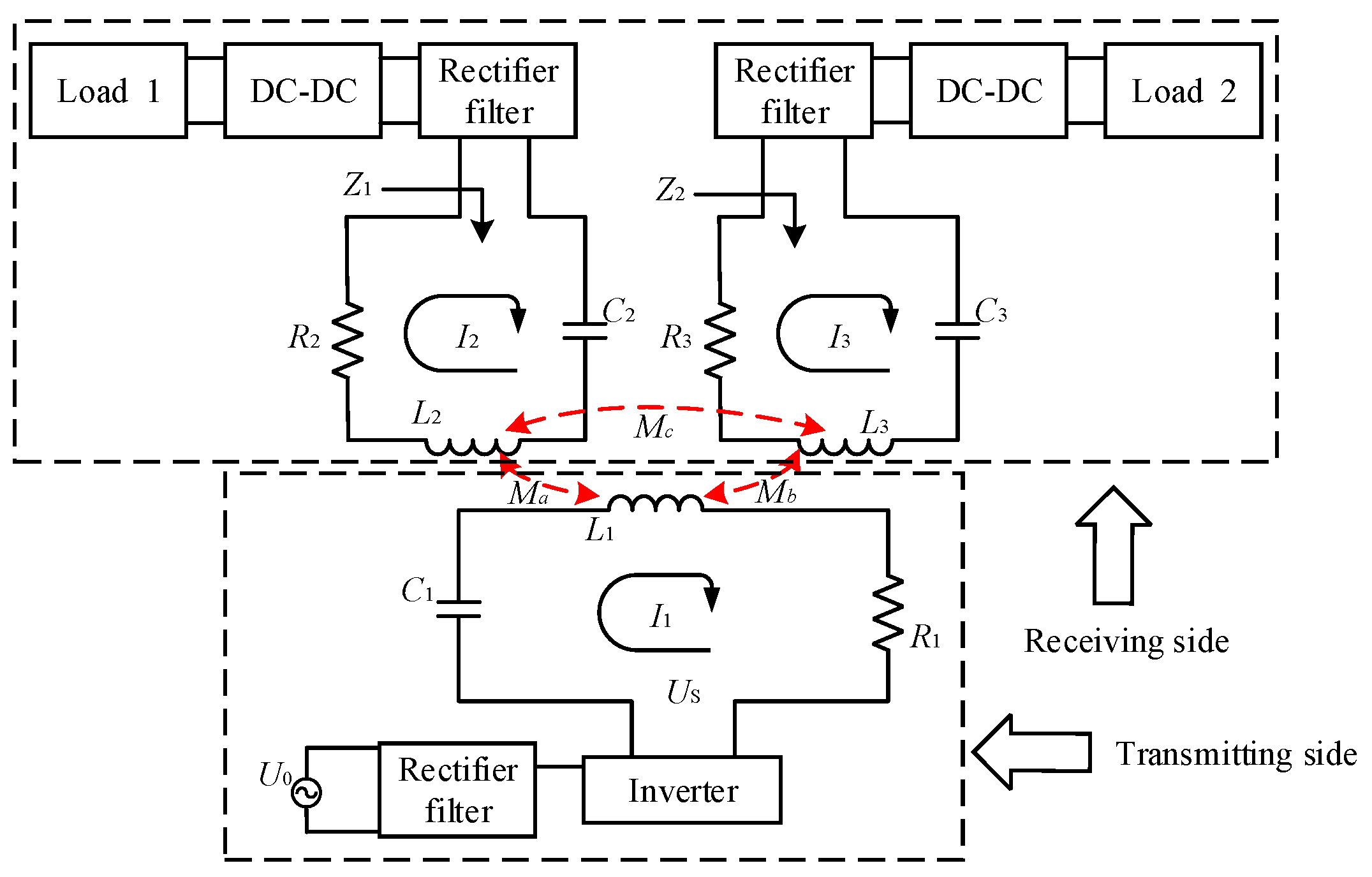
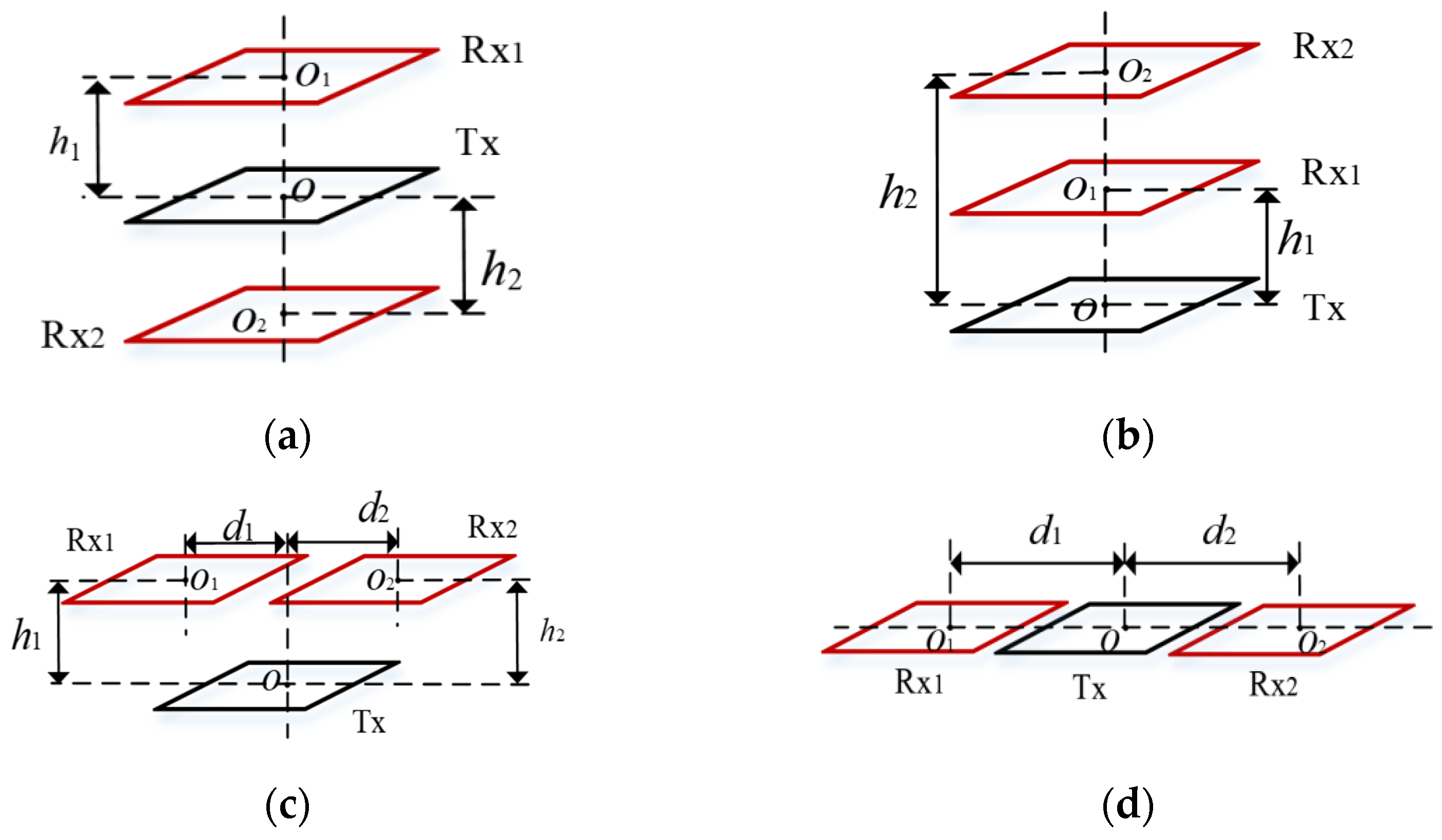
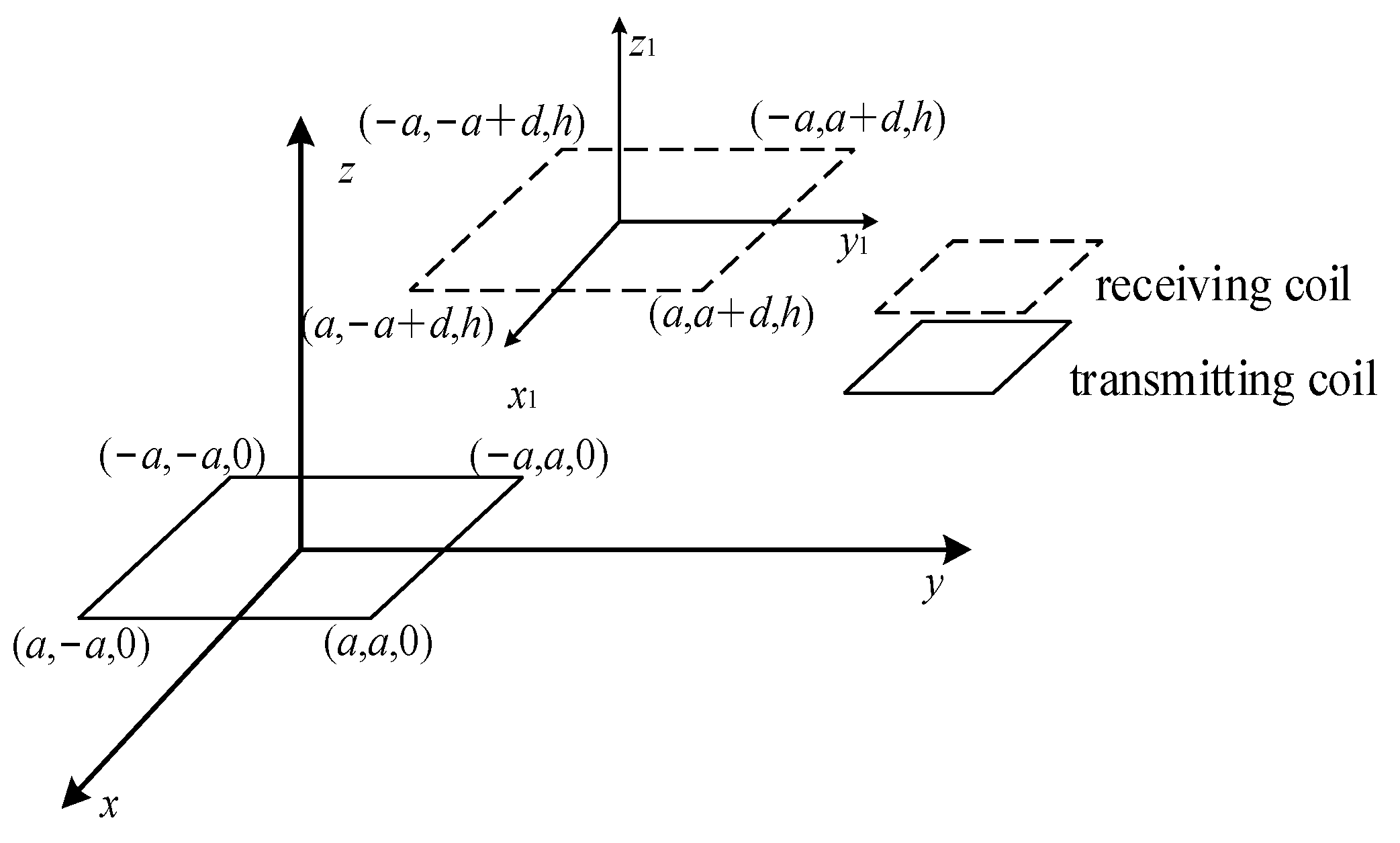

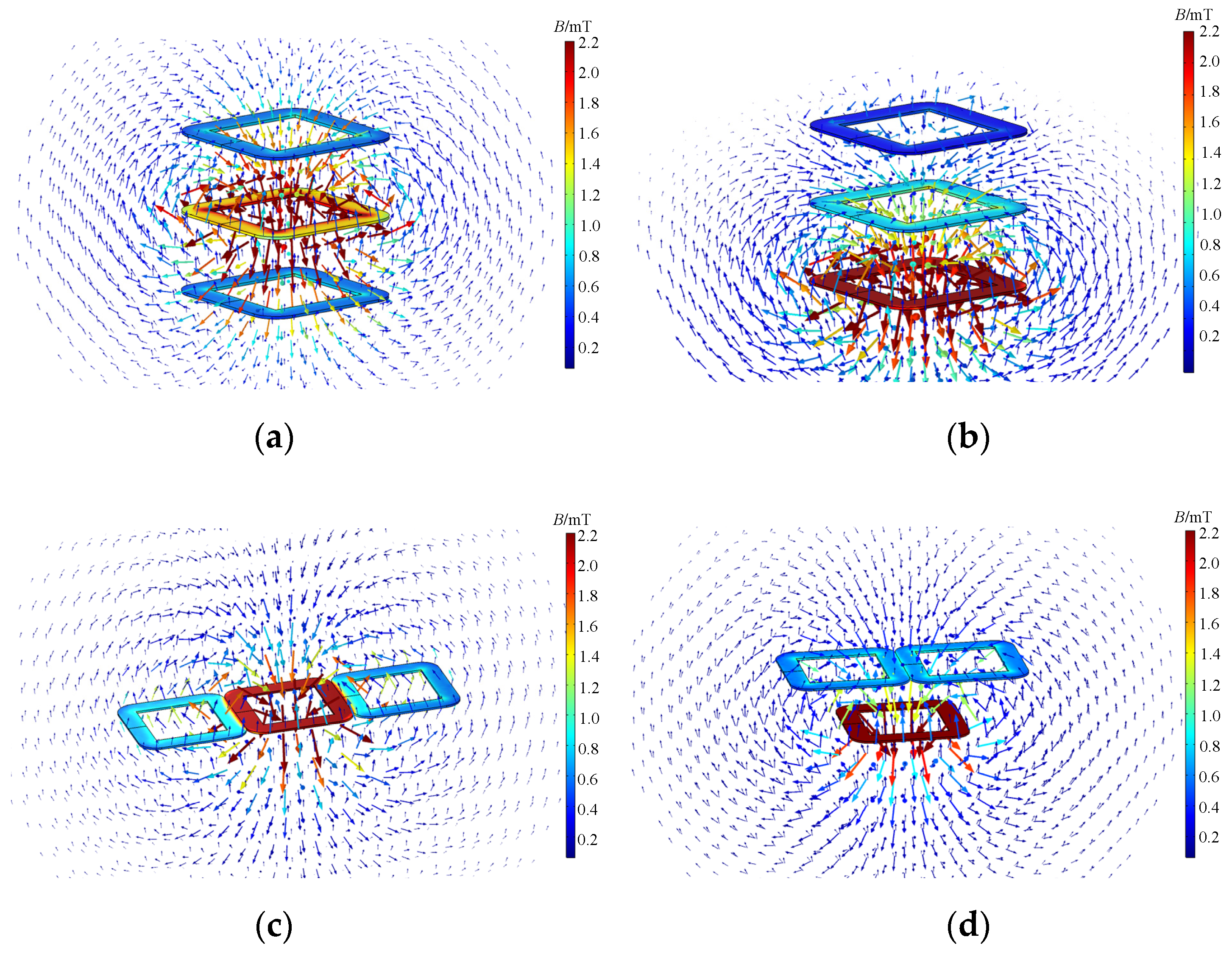



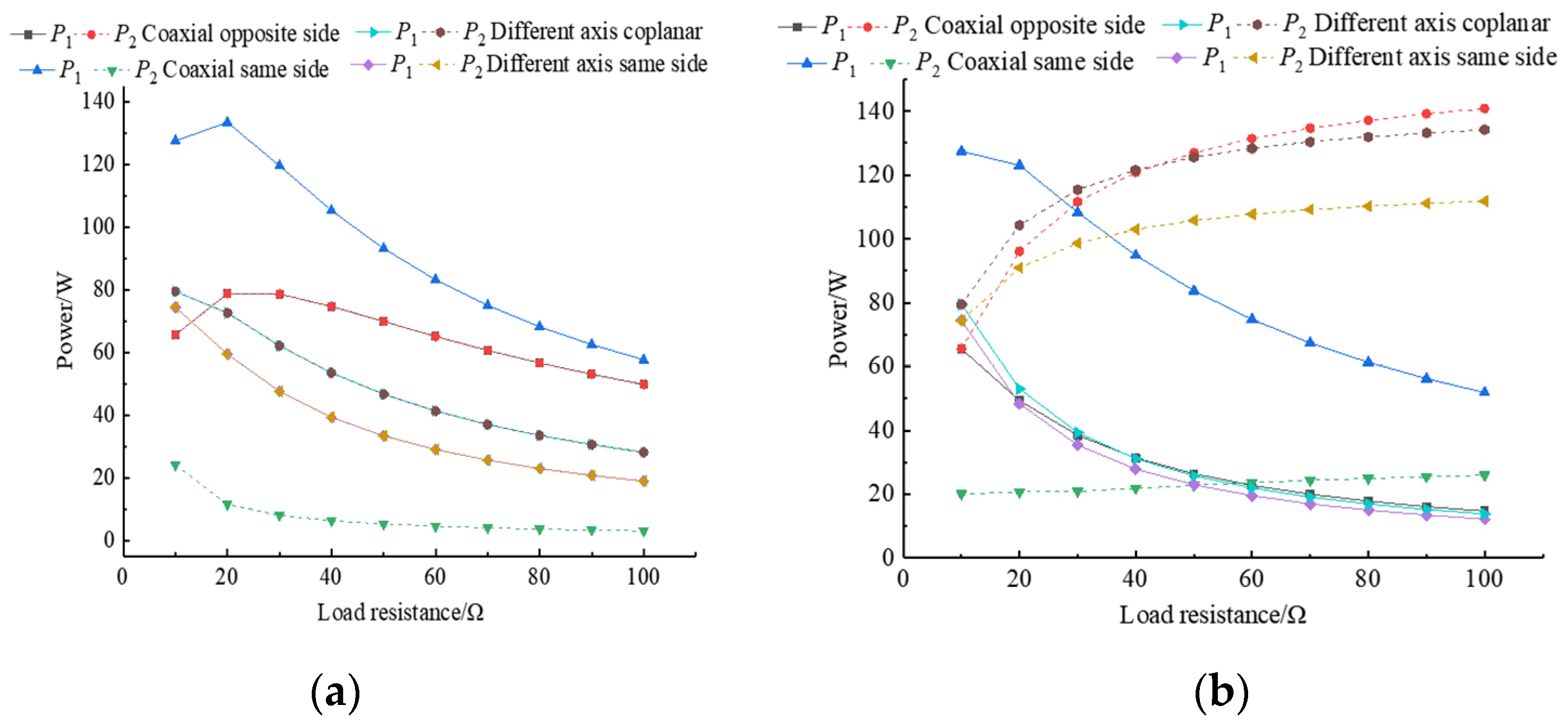
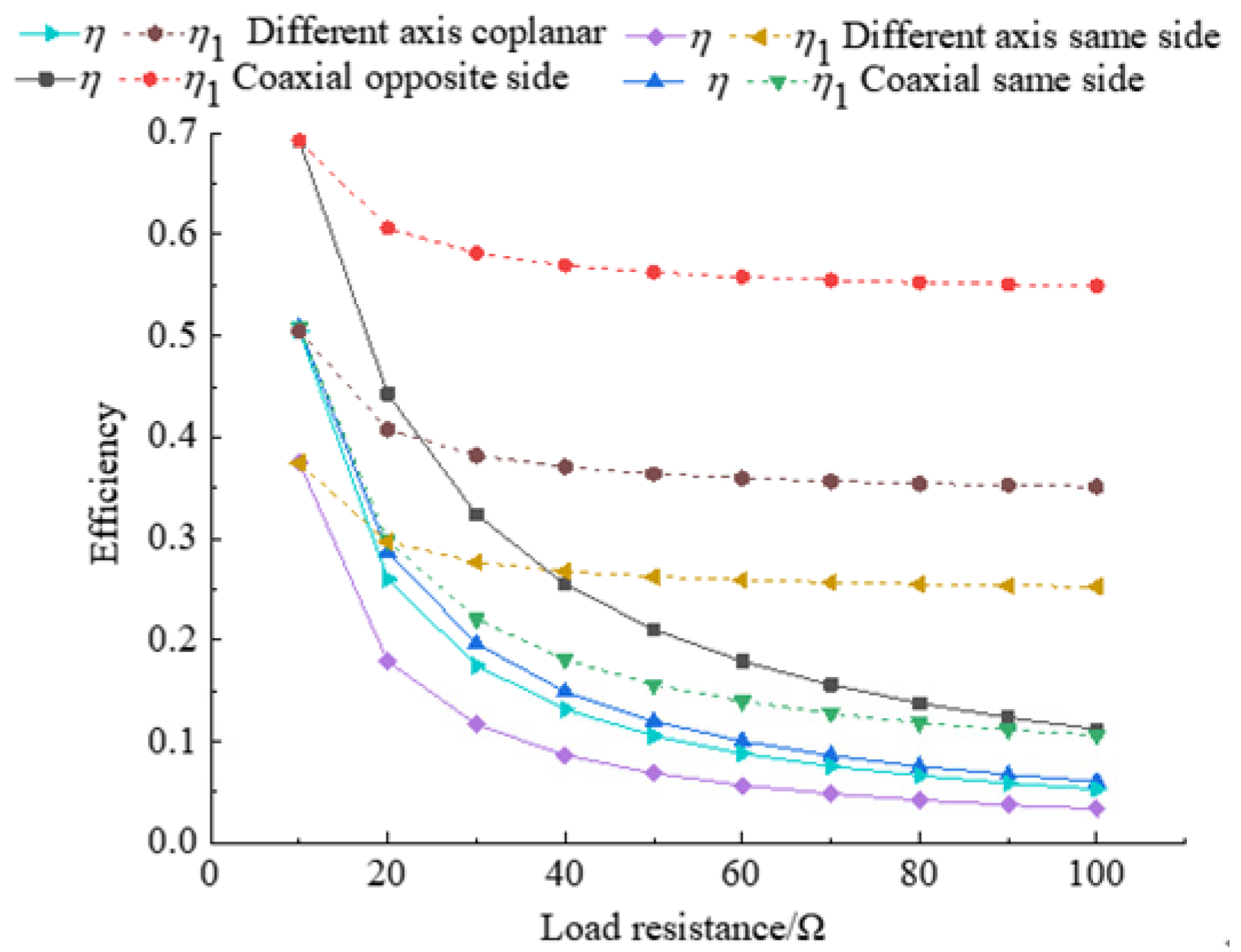

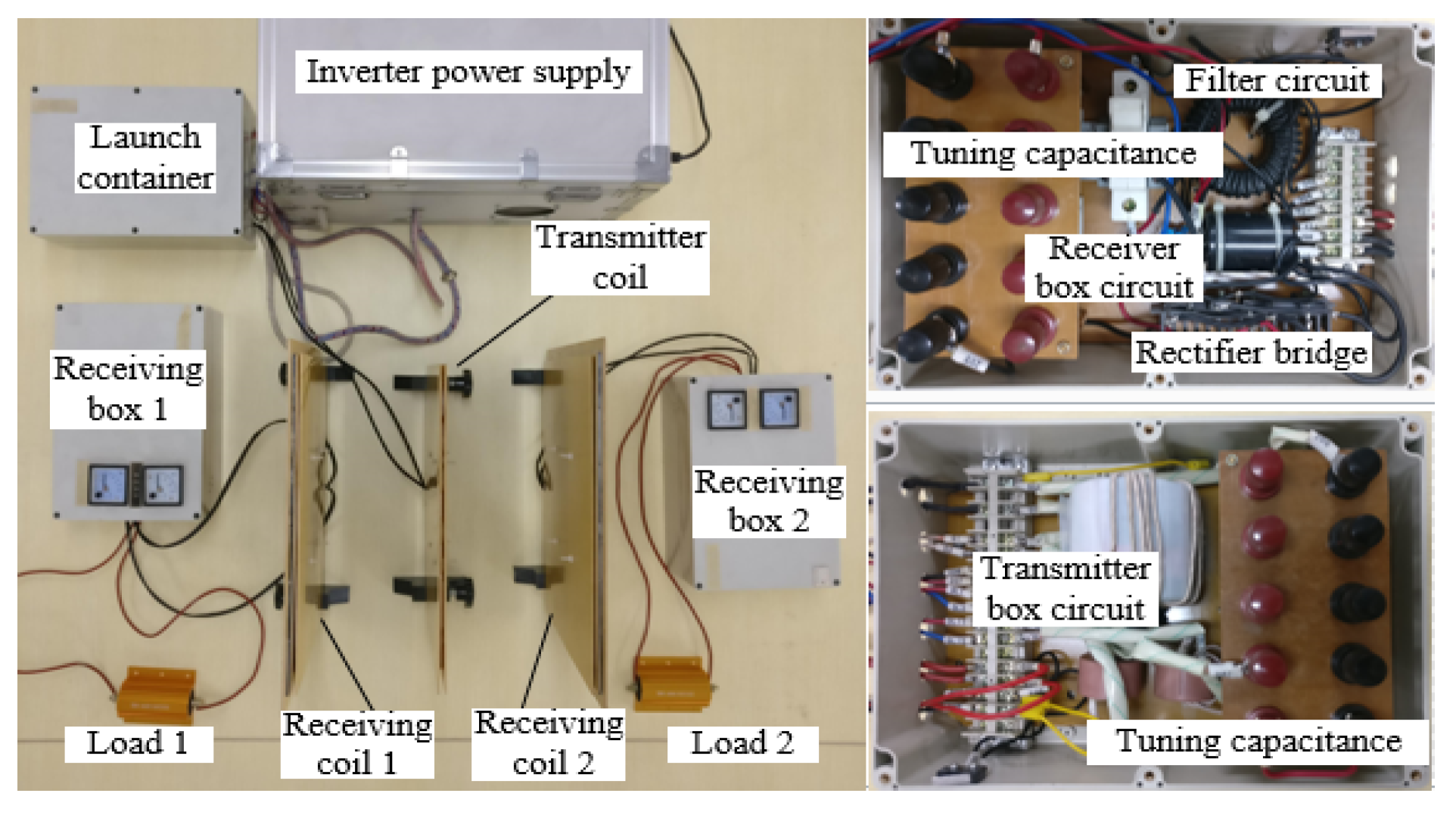
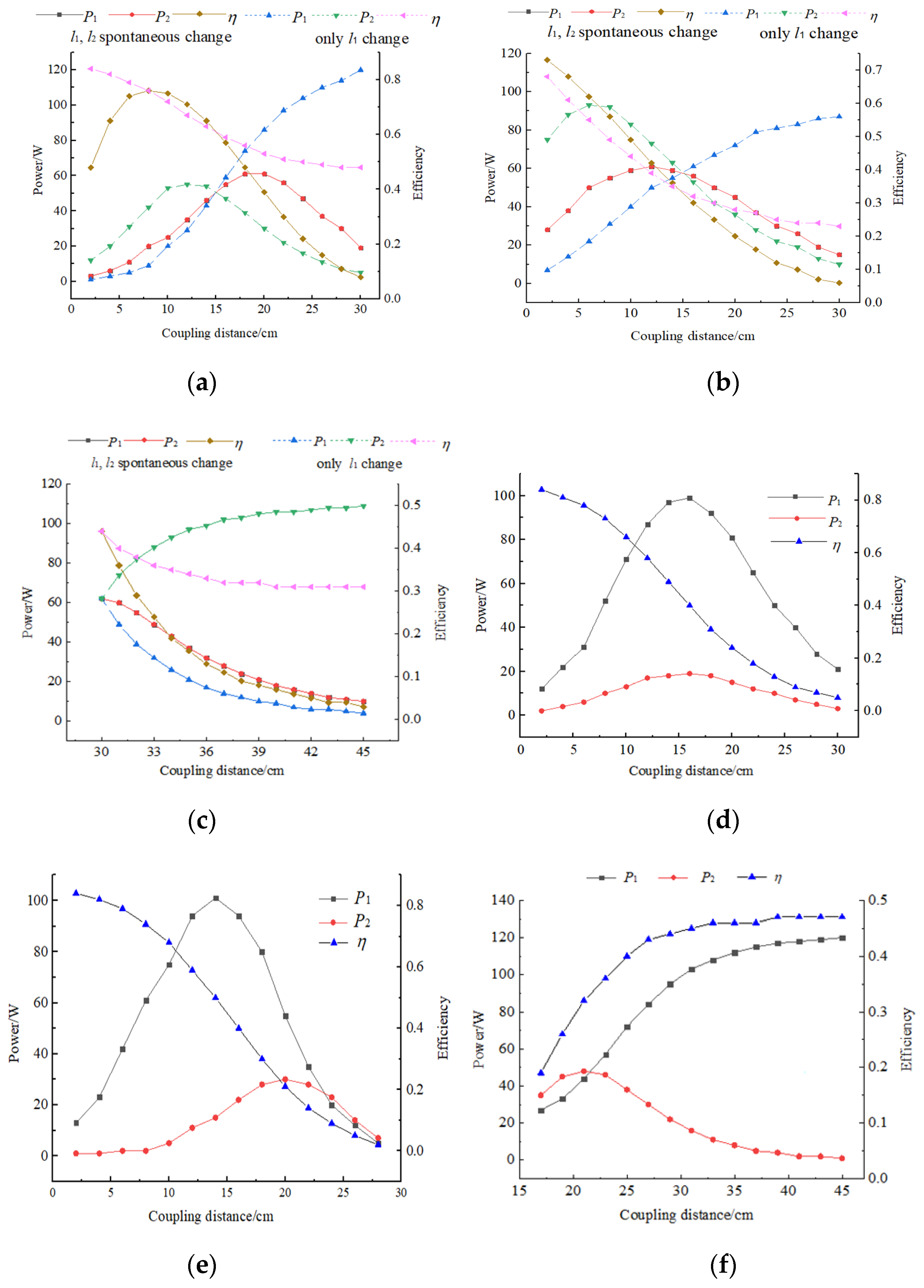

| Symbol | Transmiting Coil | Receiving Coil 1 | Receiving Coil 2 |
|---|---|---|---|
| Inductance, L/µH | 107.82 | 107.83 | 107.82 |
| Capacitance, C/nF | 19.71 | 19.70 | 19.71 |
| Coil turns, N | 10 | 10 | 10 |
| Resistance, R/Ω | 0.11 | 0.09 | 0.12 |
Publisher’s Note: MDPI stays neutral with regard to jurisdictional claims in published maps and institutional affiliations. |
© 2022 by the authors. Licensee MDPI, Basel, Switzerland. This article is an open access article distributed under the terms and conditions of the Creative Commons Attribution (CC BY) license (https://creativecommons.org/licenses/by/4.0/).
Share and Cite
Xue, M.; Hou, H.; Li, L.; Guo, J.; Zhang, P.; Zhu, G. Analysis of the Electromagnetic Coupling Characteristics of Dual-Load Wireless Power Transmission Channels. Processes 2022, 10, 1931. https://doi.org/10.3390/pr10101931
Xue M, Hou H, Li L, Guo J, Zhang P, Zhu G. Analysis of the Electromagnetic Coupling Characteristics of Dual-Load Wireless Power Transmission Channels. Processes. 2022; 10(10):1931. https://doi.org/10.3390/pr10101931
Chicago/Turabian StyleXue, Ming, Hu Hou, Longnv Li, Jianwu Guo, Pengcheng Zhang, and Gaojia Zhu. 2022. "Analysis of the Electromagnetic Coupling Characteristics of Dual-Load Wireless Power Transmission Channels" Processes 10, no. 10: 1931. https://doi.org/10.3390/pr10101931
APA StyleXue, M., Hou, H., Li, L., Guo, J., Zhang, P., & Zhu, G. (2022). Analysis of the Electromagnetic Coupling Characteristics of Dual-Load Wireless Power Transmission Channels. Processes, 10(10), 1931. https://doi.org/10.3390/pr10101931








